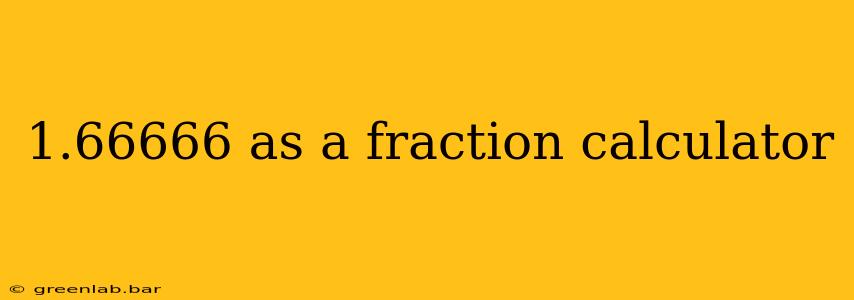Many people encounter repeating decimals like 1.66666... and wonder how to convert them into fractions. This seemingly simple task can be surprisingly tricky, but with the right approach, it becomes straightforward. This guide will walk you through the process of converting the repeating decimal 1.66666... into a fraction, explaining the underlying mathematics and providing a practical method you can use for other repeating decimals.
Understanding Repeating Decimals
A repeating decimal, also known as a recurring decimal, is a decimal number that has a digit or a group of digits that repeat infinitely. In our case, the repeating decimal is 1.66666..., where the digit "6" repeats endlessly. This is often denoted as 1.6̅, with a bar over the repeating digit.
Converting 1.66666... to a Fraction
The key to converting repeating decimals to fractions lies in algebraic manipulation. Here's how we do it for 1.66666...:
Step 1: Assign a Variable
Let's represent the repeating decimal with a variable, say 'x':
x = 1.66666...
Step 2: Multiply to Shift the Decimal
Multiply both sides of the equation by a power of 10 that shifts the repeating part to the left of the decimal point. Since only one digit repeats, we multiply by 10:
10x = 16.66666...
Step 3: Subtract the Original Equation
Now, subtract the original equation (x = 1.66666...) from the equation we obtained in Step 2:
10x - x = 16.66666... - 1.66666...
This simplifies to:
9x = 15
Step 4: Solve for x
Divide both sides of the equation by 9 to solve for x:
x = 15/9
Step 5: Simplify the Fraction
Finally, simplify the fraction by dividing both the numerator and the denominator by their greatest common divisor, which is 3:
x = 5/3
Therefore, the fraction equivalent of the repeating decimal 1.66666... is 5/3.
Alternative Method: Recognizing Common Fractions
Experienced mathematicians often recognize common fraction equivalents of repeating decimals. For example, knowing that 1/3 = 0.33333... allows for a quick calculation:
1.66666... can be viewed as 1 + 0.66666..., where 0.66666... is simply two thirds (2/3). Thus, 1 + 2/3 = 5/3.
Conclusion
Converting repeating decimals to fractions is a valuable mathematical skill. By following the steps outlined above, you can confidently convert any repeating decimal into its fractional equivalent. Remember to always simplify your final fraction to its lowest terms for the most accurate and concise representation. This process is crucial for various applications in algebra, calculus, and other mathematical fields.

